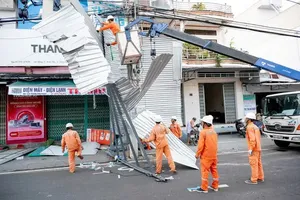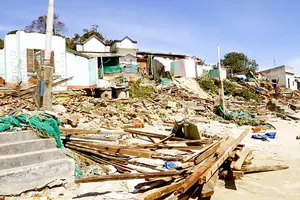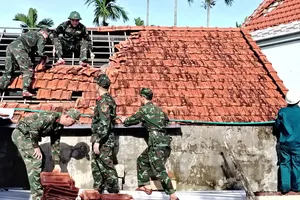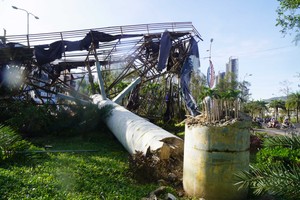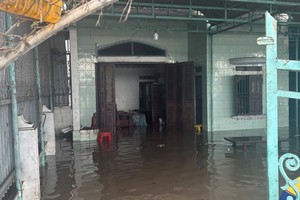
Typhoon No.13 tore through the Central region, inflicting heavy losses on coastal villages in Gia Lai and Dak Lak provinces. Hundreds of fishing boats, cages, and ponds were swept away, sunk, or severely damaged — with total losses estimated at several hundred billion Vietnamese dong.
Livelihoods at risk
At De Gi Lagoon (Gia Lai Province), the storm left behind scenes of devastation. Homes, infrastructure, and fishing vessels were badly damaged. Across the lagoon, boats lay scattered — some shattered, some stranded, and others resting at the bottom.
Fisherman Khong Trong Hieu, 52, An Quang Dong Hamlet, De Gi Commune, lost his 420-horsepower fishing vessel, which has yet to be salvaged. “Fishing has been unprofitable for months. Now my boat is sunk, all my gear is gone. The cost of lifting and repairing the vessel runs into tens of millions of Vietnamese dong — but I’ve got nothing left,” he said, his voice heavy with despair.
Nearby, fellow fisherman Tran Van Tam, 34, Chanh Loi Hamlet, has spent days mobilizing men, machinery, and tools to raise his overturned vessel BD-93766-TS, which was tossed ashore at Dam Thuy Lagoon. “Before the storm, I moved my boat deep into the lagoon and secured it with a 2.5-ton anchor,” he recalled. “But the six-meter waves broke it loose and hurled it onto the bank. The damage is severe — a lot of equipment was swept away. The loss is tremendous.”
In response, the Vietnam Red Cross Society has launched an emergency relief program to support residents in Dak Lak, Gia Lai, and Quang Ngai provinces, providing more than VND3.3 billion (in cash and goods) to help them recover from the typhoon and subsequent flooding.
Four days after the storm, the fishing hub of Vung Chao (Song Cau Ward, Dak Lak Province) remained in ruins. Numerous boats lay broken and splintered, piled atop one another after being battered by strong winds and storm surges. The air buzzed with the clamor of cranes, welding torches, and hammers as fishermen worked feverishly to salvage and repair what remained.
Some boats were damaged beyond repair — their owners could only recover the engines and scrap the rest. “My boat’s completely destroyed,” said Ngo Van Vuong of Xuan Dai Ward. “I’ve rented a crane to lift it, hoping to fix what I can — but repair costs are enormous. Minor damage costs VND20-30 million, major damage up to hundreds of millions of Vietnamese dong. I don’t know how I’ll go back to sea, or repay the bank loans.”
Calls for debt relief
According to the Cat Khanh Border Guard Station (Gia Lai Province), typhoon No.13 caused severe damage across De Gi Lagoon — sinking seven fishing boats, damaging 20, and stranding ten more. Authorities are assisting fishermen with salvage and repair operations. Major Nguyen Ngoc Duong, Head of the station, said, “Given the large number of sunken and damaged vessels, recovery efforts are extremely challenging. We are surveying the situation to propose suitable support measures and guiding locals to coordinate with maritime transport firms for salvage operations and asset protection.”
In Xuan Dai Bay (Dak Lak Province), Song Cau Ward sustained the heaviest losses. Statistics show that 30 fishing boats and 70 motorized canoes were damaged, while 60–70 percent of aquaculture cages were destroyed or swept away. The area’s lobster farms alone suffered catastrophic losses — 1,600 cages belonging to more than 2,000 households (including 700 for market-sized lobsters and 900 for juveniles) were damaged, with total losses estimated at over VND20 billion.
Mr. Vo Ngoc Thach, Chairman of the Song Cau Ward People’s Committee, said local authorities have petitioned the central government and the province for emergency aid, including debt relief measures.
“We’ve proposed that banks reschedule, defer, or write off debts for severely affected households,” he said. “People have lost nearly everything — they desperately need humane, practical support to rebuild their livelihoods.”
The Hue City Civil Defense Command issued a directive on November 10 requiring local authorities to mark the highest flood levels recorded during the heavy rains from October 25 to November 3. The markings — made in red paint — will appear on public buildings, schools, low-lying roads, and flood warning towers. The data will be submitted to the Department of Science and Technology to update Hue City’s digital flood-mapping system for future disaster prevention and management.












